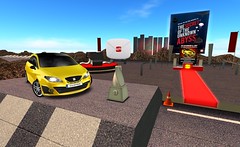
Image by Torley via Flickr
Remember that time in your teenhood when you couldn’t wait to reach the legal driving age? Getting that license meant making a major leap in the quest toward freedom and independence. We certainly took full advantage of it when we got our licenses as teens.
“Vi, where is Patty?”
“Oh Tony, she offered to go to the store to pick up milk for me. She’s such a good daughter.”
“Vi, that was eight hours ago.”
Now as parents of special children, our excitement has turned to anxiety or panic, especially when you have a teen with a disability that affects their coordination and visual perception. Driving requires the ability to make snap decisions and to manage unforeseen circumstances, something Gina or “Crash” (as she’s known as in our family) still struggles with.
“Mommy don’t tell me you hit another car in the driveway?”
“Emmy, it’s not my fault. That car wasn’t supposed to be parked in that spot. They just ignored the Park At Your Own Risk sign with the skull and crossbones that Dad put up after my last accident!”
With Gina’s daughter, Katie, approaching 16, Gina is extremely anxious about the whole driving process. On the one hand, she’s worried about Katie’s ability to drive and manage the responsibilities and challenges that come along with it. On the other, she doesn’t want to rob her daughter of an opportunity to gain independence.
“Mom, you gotta stop babying me. I want to learn to drive. I know I can do it.”
Given Gina’s anxiety over this, she was thrilled to come across this article about a new study designed to tackle autism and driving. The study involves using a simulator that would allow teens with autism to learn how to drive and to determine their level of readiness before they hit the road.
Patty was excited to learn about this, too.
“Gene, maybe you can take part in the study, too? You could use some more practice.”
What do you think? Do you have a teen with a disability who wants to drive? Does this seem like a good idea to you?









